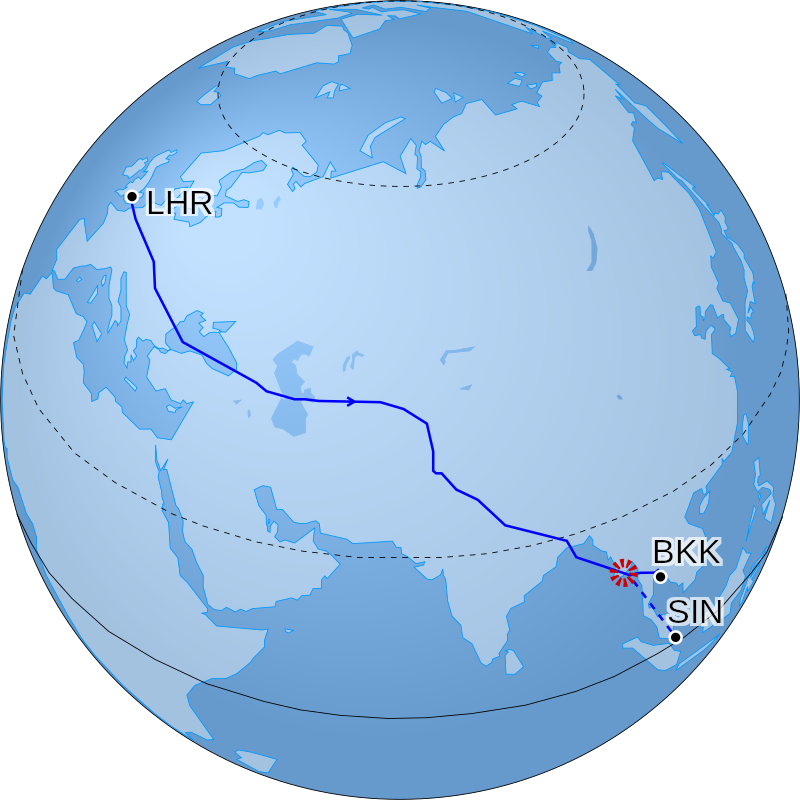
The Boeing 777-300 involved in the incident involving flight SQ321
On the 23rd of May 2024, the CEO of Singapore Airlines, Goh Choon Phong, apologized to the world of aviation after the news broke out that a British citizen had lost his life on a flight operated by Singapore Airlines. The flight SQ321 took off from Heathrow on the 20th of March with 211 passengers and 18 crew onboard. Data shows that only 1.13 people per million passengers are likely to lose their lives in a flight, which goes to show how unfortunate the episode was, and Phong’s words and tone set the tone of empathy heard across the world of aviation.
Details of the flight SQ321
The Singapore Airlines flight SQ31 had taken off at 10:38 am. The New York Times cited a popular flight tracking website in the report it had published about the incident:
“Data on Flight Radar 24, a website that compiles public information about flights, appears to show that about 10 hours later, it went from 37,000 feet to an altitude of roughly 31,000 feet in only a few minutes.”
The aircraft in question was a Boeing 777-300ER, a variant of the Boeing 777 family, which includes one of the largest passenger aircraft to have been ever made. Reports from BBC have it that the fact that the incident took place in less than 10 seconds didn’t give anyone enough time to respond. To add to the issue, many people onboard were sleeping.

The intended flight path versus where the flight SQ321 landed
The incident resulted in the injury of seventy-one people who were being treated at a hospital in Bangkok. Six of them are critically injured. The uninjured 143 passengers were flown to Singapore overnight. The lone fatality of the incident was a 73-year-old person by the name of Geoff Kitchen, who died of a suspected heart attack
Clear Air Turbulence has been regarded as a suspect for the whole cause but New York times had a skeptical tone with regards to the matter:
“ It’s unclear what caused the episode. As the plane traveled across Myanmar, satellite data showed a strong storm beginning to form and bubble into the higher elevations, which suggests that the atmosphere in the region was becoming unstable. The plane was also moving toward other storms that were developing along the coast of Myanmar.”
Singapore Airlines CEO’s apologetic words
Mr. Phong apologized for the event in a video he had posted on social media, as he said:
“We are deeply saddened by this incident. It has resulted in one confirmed fatality, and multiple injuries. On behalf of Singapore Airlines, I would like to express my deepest condolences to the family and loved ones of the deceased. We are very sorry for the traumatic experience that everyone on board SQ321 went through.”

Goh Choon Phong, the CEO of Singapore Airlines, who apologized for the traumatic experience of the passengers onboard SQ321.
He further went on to say,
“Singapore Airlines will continue to extend all possible support to them [the injured and affected]..Once again, our deepest apologies to everyone affected by this incident. Please be assured that Singapore Airlines is here to help and support you during this difficult time.”
What can be done to placate the incidents of Clear Air Turbulence such as that of SQ321?
Over 12,000 Delta Airlines pilots currently use tablets equipped with turbulence forecasting tools. The tool allows them to check for the possibility of the development of clear air turbulence conditions along their flight paths. We might also see international carriers such as Qantas, Air France and Lufthansa use such tools. With clear air turbulence on the rise, the manufacturing giant Boeing has also offered a purchase option for such a tool in their new aircraft.

Photo: John Robert McPherson | Wikimedia Commons
Robert Sharman, researcher of turbulence at the National Center for Atmospheric Research (NCAR), talked to National Geographic about the need for computing technology to deal with the problem:
“We better understand the atmosphere now, and our computing ability has meant we can provide better descriptions of turbulence. By its very nature, turbulence is so chaotic that you need a lot of computer power to throw at it before you can see what is actually happening. This observing strategy is a breakthrough for us.”
